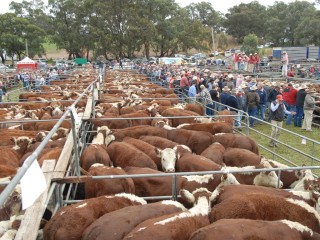 Apart from supply areas directly affected by the cessation of live export trade with Indonesia, the broader cattle market across Eastern Australia has remained remarkably resilient to the industry crisis.
Apart from supply areas directly affected by the cessation of live export trade with Indonesia, the broader cattle market across Eastern Australia has remained remarkably resilient to the industry crisis.
While the general cattle market is under some pressure at present from a variety of other influences, little of this could be attributed directly to the recent live export developments, Meat & Livestock Australia’s market information and analysis manager Tim McRae says.
“Would the market position we see today be any different if the live export closure had not occurred? I would say not,” he said yesterday.
“What’s weighing heaviest on the market at the moment is the uncertainty surrounding the live export situation. But in reality, the real impact on the market is flat demand in Japan, the continuing impact of the currency value, and perhaps, excess beef volume diverted from export onto the domestic market.”
National livestock agency regional managers contacted in Southern NSW and Queensland yesterday said they were under instructions not to discuss matters associated with live export with the media. However both confirmed that there had been little or no evidence of impact on local cattle market supply/demand dynamics.
 Mr McRae said cattle numbers in many southern Queensland selling centres were back this week, according to NLRS reports, and the Longreach sale on Wednesday was reported as a ‘solid’ market.
Mr McRae said cattle numbers in many southern Queensland selling centres were back this week, according to NLRS reports, and the Longreach sale on Wednesday was reported as a ‘solid’ market.
There was little or no evidence of panic selling out of the live export supply footprint region putting supply pressure on selling centres or meatworks, he said.
While Jap ox indicator prices in Queensland this week were down 6c, they were steady in NSW, but any decline was due principally to soft demand, not an abundance of cattle.
“Any cattle flow out of the Northern Territory or other live export regions is not going to be in heavy cattle. They should be having no impact whatsoever on the heavy end of the market,” Mr McRae said.
It would take anything from six to eighteen months for many of the northern cattle to reach killable weights, by processing standards, meaning any surge of slaughter cattle was still a very long way off.
There may be some moderate impact on the store market and lighter cattle, but the EYCI has been unchanged for the past three days, and has slipped less than 4c in the past week.
“While the Indonesian closure has obviously had a big impact on cattle values in far northern regions, I cannot see evidence of a significant impact further south. If there is any influence, it is simply in uncertainty in producers minds,” Mr McRae said.
The best way to alleviate that would be some form of market re-opening, even if it was only partial.
“As soon as some boats moving, even if only a few, it releases the pressure valve to some extent – both psychologically and in a physical market sense,” he said.
Season provides breathing space
The single biggest salvation under the current difficult circumstances in the north was the shape of the season.
“The season is giving people time to make decisions. If this closure had come after a poor northern wet season, it would have had a much, much worse outcome. Producers in many areas this year at least have some breathing space to consider their options.”
Mr McRae said preliminary indications suggested that beef trade into most export markets would continue to be ‘slow’ during June, with the exception of Korea.
While there had been some debate over how much product diverted out of export the domestic market could absorb at present, given the general flat state of the economy, demand appeared to be holding up quite well.
“But it is only one market, and there must be a finite limit to how much beef volume the domestic trade can absorb before prices start to be more seriously affected,” he said.
One positive for Australian beef’s international competitiveness position might come from softening currency value.
While it was still early times, latest developments in the European Union where countries like Greece are again in serious financial trouble, could impact on the value of the A$ (see separate story).
The A$ has moved lower in recent days, sliding to below US105c overnight – the first time in quite a while – mostly as a result of the European developments.
“The same happened in 2008, when the A$ fell due to uncertainty in Europe and North America,” Mr McRae said. “Investors during such times back-out of other currencies and head for US currency – even though that does not make much sense at the moment,” he said.
“Even an A$ at parity would be an advantage, compared with the current situation. The dollar was high also around January, but international beef markets were far more buoyant five months ago.”



HAVE YOUR SAY